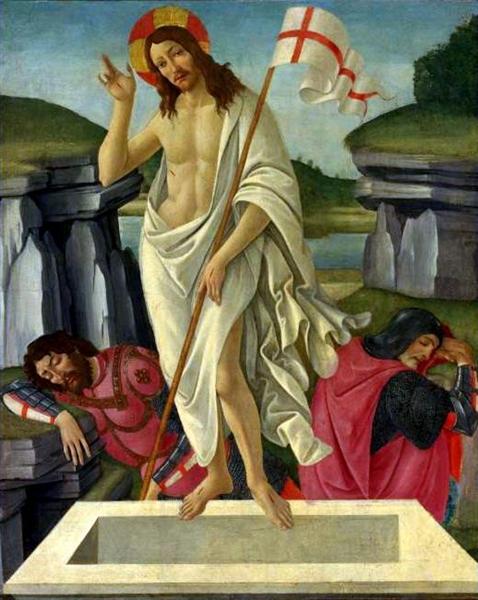Beskrivelse
Sandro Botticelli's painting "The Resurrection," created around 1490, is a seminal work that encapsulates both the artist's technical mastery and the deep religious convictions of the Renaissance period. Known for his elegant style and interest in the idealized representation of the human figure, Botticelli offers in this work a unique interpretation of the central moment of Christianity: the resurrection of Christ.
The composition is characterised by a vertical approach, with Christ, in the centre, emerging from his tomb with an imposing posture that radiates both calm and authority. His figure is depicted with a realism that contrasts with the more ethereal surroundings, and his expression denotes a sense of transcendence. Dressed in a shining white robe, he symbolises purity and divinity, while the red banner he holds in his right hand is an emblem of triumph over death. His luminous figure captures the viewer's attention, who is guided towards the central action of the Resurrection.
The painting's setting is equally significant. The background shows a landscape in which rolling hills and flowering trees can be seen, suggesting a rebirth of nature in parallel with the resurrection of Christ. This connection between the sacred and the earthly is common in Botticelli's work, who often integrates natural settings that allude to the beauty of divine creation.
The colour palette is composed of soft and harmonious tones, with whites, blues and greens predominating, creating an atmosphere of serenity and hope. These colours combine to give vigour to the scene, accentuating both the central figure and the elements surrounding it. Botticelli, famous for his use of colour and light, achieves a delicate balance here between light and shadow, leading the viewer into a contemplative state.
The work also features other important characters, although in a more secondary representation. At the bottom left, figures that appear to be the soldiers guarding the tomb can be seen, displaying reactions of surprise and wonder at the miracle they witness. These figures add a sense of realism to the narrative and reflect a human response to divinity. They also reflect Botticelli's attention to human interaction at sacred events, a theme that appears in several of his works.
From a historical perspective, The Resurrection is set in a time of great religious fervour in Renaissance Italy, a period that sought a revaluation of Christian beliefs and traditions. Botticelli, who was influenced by the intellectual climate of his time and the writings of religious reformers, conveys in this work his own devotion and commitment to the message of hope that the Resurrection represents.
Often in contrast to contemporary works that display a more dramatic and narrative approach, Botticelli's interpretation is more introspective and spiritual. His fluid style and emphasis on the idealized beauty of the figures underline the Renaissance search for aesthetic perfection and harmony.
The Resurrection is ultimately a work that not only celebrates one of Christianity’s most important narratives, but also reflects the artistic evolution of its creator and the cultural climate of his time. It is a testament to how painting can serve as a powerful medium to explore themes of life, death and renewal, resonating through the centuries as a symbol of faith and hope.
KUADROS ©, a famous painting on your wall.
Hand-made oil painting reproductions, with the quality of professional artists and the distinctive seal of KUADROS ©.
Painting reproduction service with satisfaction guarantee. If you are not completely satisfied with the replica of your painting, we will refund 100% of your money.

